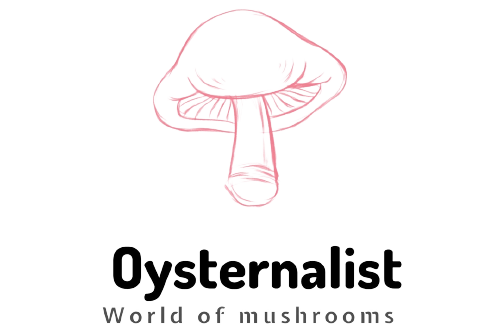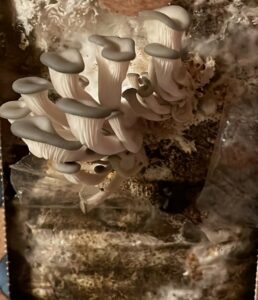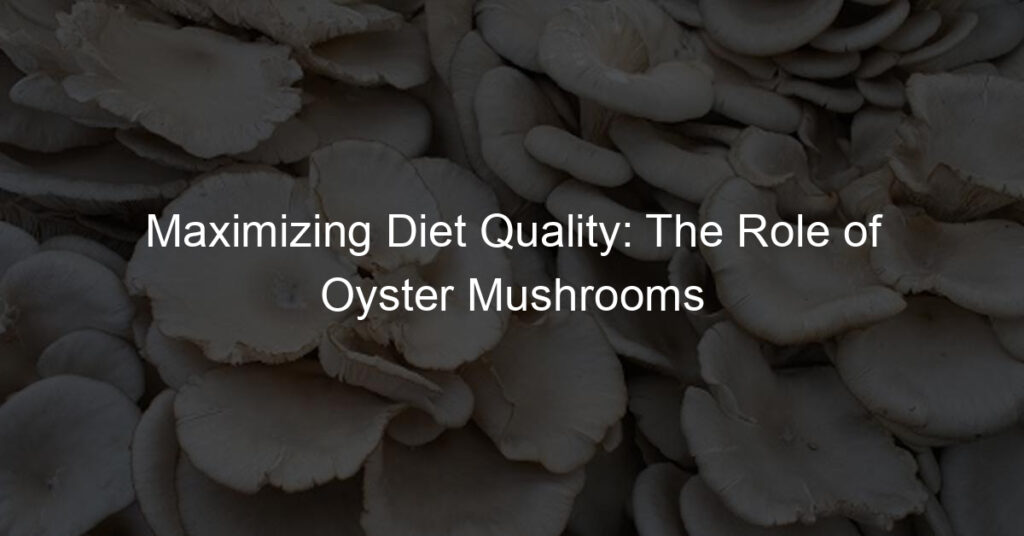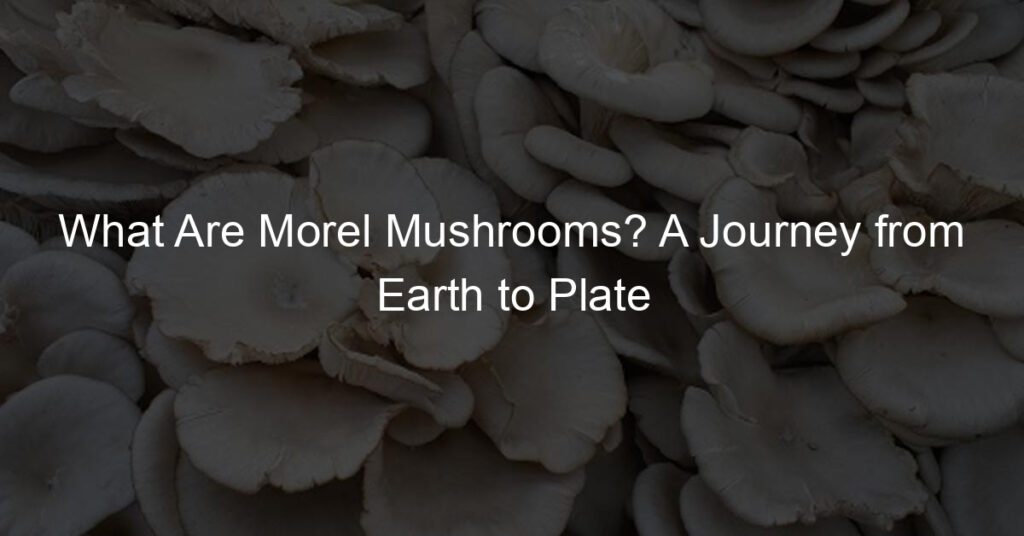I know the feeling when a unique flavor, like oyster mushrooms‘, sparks our curiosity and fills us with countless questions. It’s not just you; we’ve all been there! For me, decoding their delicate earthy oyster-like flavor was nothing short of an adventure.
Their flavor also tends to vary according to the type of forest they grow in and what other plants are present at the same time. Not all oyster mushrooms taste like oysters!
Here is a nifty guide to help you unravel the mysteries behind these intriguing fungi right from your kitchen -Isn’t it exciting? So buckle up and let’s journey together into this fascinating world of oyster mushrooms! Enjoy the ride!
Key Takeaways
- Oyster mushrooms have a mild flavor with earthy undertones and a hint of sweetness and nuttiness. Some even say they taste like chicken!
- When cooked, these mushrooms become tender and velvety. Larger varieties can be chewy and meaty, perfect for replacing meats in dishes.
- Cooking is necessary; raw oysters might upset the stomach! These fungi work great on stir-fries, soups, roasts, or BBQs due to their durable texture.
- Maintain mushroom quality by gently cleaning them with a cloth or brush (no soaking!) Cut off tough stems before cooking for best results.
What Do Oyster Mushrooms Taste Like?
Oyster mushrooms possess a delicate flavor; think of it as mild, with subtle earthy undertones. They carry a certain sweetness and traces of nuttiness that make the taste unique.
Interestingly, some folks argue that these mushrooms actually taste like chicken! Their name stems from their subtle seafood-like flavor, resembling actual oysters.
Delicate flavor with a mild earthiness
Oyster mushrooms are notable for their delicate flavor profile that’s laced with a mild earthiness. This unique taste component is what sets them apart from other mushroom varieties that tend to have an overly dominant earthly flavor.
The mellow, yet distinctively crisp savor of oyster mushrooms leaves your palate refreshed and wanting more, making them an interesting ingredient in various cuisines. Their subtle fresh undertones add depth and dimension to dishes without overpowering the main ingredients, enabling versatile use in cooking applications from sautés to grills or even delightful raw accompaniments!
Sweet and slightly nutty undertones
Some might say the delightful charm of oyster mushrooms lies in their slightly sweet and subtly nutty undertones. This unique flavor profile sets them apart from other popular mushroom varieties, offering an exciting alternative burst of taste to any dish they grace.
As I cook my oyster mushrooms, their inherent sweetness gets amplified, transforming them into something equally delicious as it’s nutritious.
The nuttiness that emanates from these charming fungi further enhances its persona in the culinary world. Each variety bears this characteristic to a degree; king oyster mushrooms, for instance, display this element more profusely with others like blue oysters offering a mild yet noticeable hint of woodsy notes along with it.
No matter what type you have at hand – be it golden oysters or pink pearl ones- every bite assures promises a tantalizing dance of sweet and nutty accents on your tongue!
Do oyster mushrooms really taste like chicken?
Some people might claim that oyster mushrooms taste like chicken, but the comparison isn’t entirely accurate. It’s true, the flavor of these delectable fungi is somewhat meaty with a delicate seafood aura similar to their namesake bivalve.
Yet the unique earthiness and subtle nuttiness keep them distinct from poultry’s more neutral profile. So, while they don’t replicate chicken’s exact taste, their satisfyingly chewy texture certainly brings a hearty substance to dishes traditionally dependent on meats.
You may find yourself pleasantly surprised by how well this tasty mushroom can stand as a protagonist in your culinary creations!
Similar to seafood or oysters, hence the name
Oyster mushrooms inherit a distinct flavor profile that sets them apart from other varieties. The name “oyster mushroom” captures this unique character. Their taste is reminiscent of seafood, giving off a slight oceanic hint, just like actual oysters.
You can find this subtle marine note, especially in certain types such as the pink oyster. It isn’t overwhelming and blends smoothly with the mildly earthy tones that encompass the overall mushroom flavor spectrum.
This briny depth gives an unexpected richness to your dishes, much like seasoning it with sea salt or kelp would do! Even if you’re not into seafood, don’t let their namesake deter you – these mushrooms won’t make your meal taste fishy; instead, they’ll provide a nuanced umami accent much sought after in many cuisines.
Texture of Oyster Mushrooms
Offering a tender, velvety texture when cooked and a meaty chewiness in larger varieties, oyster mushrooms add a distinctive touch to myriad cuisines. Want to learn more about these fascinating fungi? Keep reading!
Tender and velvety when cooked
Cooking oyster mushrooms brings about a fascinating transformation. From their raw state, these fungi evolve from a somewhat spongy texture to something smooth, tender, and velvety upon simmering, sautéing or grilling.
The cooking process releases an irresistible earthy flavor that complements the change in texture tremendously well.
During this metamorphosis in the kitchen, varieties of oyster mushrooms react in slightly different ways. For instance, pink oyster mushrooms morph into morsels that are not just velvety but also slightly chewy to bite into – adding another layer of pleasant complexity to a dish.
This versatile feature pairs wonderfully with many ingredients and accommodates various culinary styles across numerous world cuisines.
Chewy and meaty in larger varieties
Oyster mushrooms lend a chewy, meaty texture when incorporated into various dishes. This quality shines particularly in the larger varieties where the flesh is more compact and robust.
These characteristics make oyster mushrooms an excellent alternative to meats like chicken or beef in your cooking. Even better, consider experimenting with thicker blue oyster mushrooms as their naturally firmer structure gives an added heft and bite to the meals you prepare!
Culinary Usage of Oyster Mushrooms
A King among mushrooms, the versatile Oyster mushroom elevates any dish it graces, whether roasted to a tender perfection or sautéed till it sings. If you are still eager to explore their diverse culinary roles, Read on!
Should oyster mushrooms be cooked?
Yes, you must cook oyster mushrooms before eating. Raw oyster mushrooms contain a protein that can be tough to digest and occasionally cause a mild upset stomach. Heating these delightful fungi not only removes this problem but also brings out their rich and distinctive flavors akin to seafood or meaty dishes.
Cooking softens the texture of the mushroom, making it smooth and tender to eat while enhancing its delicate flavor profile, offering a highly enjoyable culinary experience overall.
From sautéing with butter in a pan to grilling them on skewers for an outdoor barbecue, there are many ways one can prepare delicious dishes using cooked oyster mushrooms without compromising on taste or nutrition!
Versatile ingredient in various dishes
Oyster mushrooms are a culinary delight due to their amazing versatility.
- These mushrooms serve as an excellent addition to stir-fries tomato-based, Their meaty texture holds up well under high heat, adding a decadent touch to any vegetable mix.
- They shine in soups and stews as they can absorb the flavors of the broth while contributing mild earthiness.
- Try roasting them with root vegetables. The robust flavor of oyster mushrooms combines wonderfully with the sweetness of roasted carrots or beets.
- Grilled oyster mushrooms make a delicious side dish at barbecues. Their tender and smooth texture provides a delightful contrast to crisp, charred edges.
- Considering pasta? Toss them in as they pair well with creamy or tomato-based risotto stir-fries, and tomato-based risotto sauces, adding depth to the overall flavor profile.
- Oyster mushrooms work incredibly well in risotto. As they cook, they release their juices into the rice creating an ultra-creamy and rich dish.
- Even in raw salads, thinly sliced oyster mushrooms contribute a unique twist. Opt for smaller and younger varieties as they’re more delicate and palatable raw.
Ideal for sautéing, stir-frying, or grilling
Oyster mushrooms earn top marks in kitchen versatility. Their earthy flavor and tender texture respond beautifully to heat, making them a perfect choice for sautéing, stir-frying, or grilling.
Need a champion ingredient for your next BBQ? Try threading these delicious fungi onto skewers and let the grill work its charm. Rather whip up something quick yet flavorful? Sauté oyster mushrooms with some garlic and toss them into pasta.
The culinary options are endless thanks to this meaty mushroom variety that can hold its own against strong cooking methods like frying or roasting while still delivering on taste.
Complements both vegetarian and meat-based dishes
The versatile flavor of oyster mushrooms seamlessly blends into both vegetarian and meat-based meals. If you’re crafting a delicious veggie stir-fry, adding these mushrooms brings a satisfying earthy depth.
In meat dishes like beef stroganoff, the hearty texture of oyster mushrooms provides an elegant contrast to tender pieces of steak. Chefs across the globe consistently use this edible fungus as a secret ingredient to enrich their culinary creations, regardless of whether it’s vegan or omnivorous fare.
Truly, the possibilities with oyster mushrooms in your kitchen are only limited by your imagination!
Handling Oyster Mushrooms
When handling oyster mushrooms, start by gently cleaning them with a damp cloth or soft brush to remove any debris. Avoid washing them under running water as they can become soggy and lose their flavor.
Before cooking, cut off the tough stems that may be difficult to chew. Storing your fresh oyster mushrooms is crucial for maintaining their quality; keep them in a paper bag or container and place them in the refrigerator.
This will allow them to breathe while keeping moisture at bay, ensuring they stay fresh longer.
Gently clean with a damp cloth or brush
Taking care of oyster mushrooms starts with gentle cleaning. Here are the ideal steps to follow:
- Pick up an oyster mushroom and inspect it for any visible dirt or debris.
- Grab a damp cloth or soft brush to remove any unwanted particles.
- Use a light, brushing motion. You don’t want to damage the delicate texture of the mushroom.
- For stubborn pieces of dirt, a quick rinse under water might be necessary. But remember, do not soak them! Oyster mushrooms absorb water quickly which can make them slimy.
- Do a quick check again to ensure all dirt is removed before moving on to the next mushroom.
Remove tough stems before cooking
Taking the hard stems off prior to cooking is an essential step in preparing oyster mushrooms. Below is a quick guide on how to do this.
- First, hold the mushroom by its cap.
- Gently pull apart the stem from the cap.
- If preferred, use a sharp knife to cut out any remaining stem.
- Note that while edible, oyster mushroom stems can be tough and have a tasteless flavor profile.
Store in a paper bag or container in the refrigerator
It’s a crucial step to store your oyster mushrooms correctly for longevity and freshness. Here are some helpful tips for proper storage:
- Choose either a paper bag or container as the primary storage unit.
- Position the mushrooms in the refrigerator, not in room temperature locations.
- Avoid using water or moist environments when storing, as this can spoil them.
- If keeping them in their original package, make sure it’s porous or made of paper to extend their shelf life.
- Use within a week of purchase to guarantee utmost freshness and flavor.
- For long-term freezer-safe preservation, freezing can be considered; simply seal them in a freezer-safe bag or container and they will last from three to six months.
Nutritional Benefits of Oyster Mushrooms
Oyster mushrooms are a healthful addition to your diet, being low in calories and fat yet packed with protein, fiber, and vital vitamins. They also contain antioxidants that bolster your immune system’s strength.
Discover more nutritional facts of these delicious fungi as you continue reading!
Low in calories and fat
Oyster mushrooms are a fantastic addition to your meal plans when you’re counting calories. With just about 65 calories in a full cup, they give you culinary enjoyment without piling on extra energy intake.
Carefully incorporating them into diet menus proves beneficial as their presence lessens worry about crossing calorie limits.
Not only do oyster mushrooms hold back on the caloric punch, but they also practice similar restraint with fat content. The fat in these edible fungi is negligible at less than 1 gram per cup serving size! Including them more frequently in meals can assist anyone who’s conscious about maintaining lipid levels while enjoying diverse flavors and textures from food fare.
Good source of protein, fiber, and essential vitamins
Oyster mushrooms stand out not just for their unique flavor but also for their impressive nutritional value. They are packed with protein, essential for building and repairing body tissues.
Not to be left behind is the fiber content that offers benefits such as improving bowel health and aiding in weight management. Additionally, these mushrooms serve up a healthy dose of vitamins like B2 (Riboflavin) and B3 (Niacin), vital for energy production and maintaining good skin health.
Consumption of oyster mushrooms could be a stealthy way of stocking your body’s nutrient reserve to meet daily requirements while enjoying an exceptional culinary experience!
Contains antioxidants and immune-boosting properties
As a beneficial bonus, oyster mushrooms offer not only their unique taste but also noteworthy health benefits. These fungi are packed with natural antioxidants like ergothioneine and glutathione, compounds that actively fight against cell damage in the body.
But the goodness doesn’t stop there! The immune-boosting properties of these wonderful morsels work to enhance your overall immune system function, demonstrating how delightful cuisine can hand-in-hand support bodily wellness.
With every bite of an oyster mushroom dish, you’re not just treating your taste buds, you’re investing in healthier living too!
Resources for Oyster Mushroom Recipes and Inspiration
Numerous digital platforms offer magnificent resources to explore oyster mushroom recipes. Cooking blogs, foodie websites, and social media pages are treasure troves of mouthwatering inspiration that showcase this versatile fungus.
From creamy soups and savory stir-fries to crispy pan-sear or sumptuous grilled delicacies, these online hubs share a plethora of ways for cooking enthusiasts to harness the delicate flavor of oyster mushrooms.
In addition to featuring delectable recipes, several well-known chefs publish videos demonstrating various techniques essential when preparing dishes with oyster mushrooms.
These informative clips not only provide step-by-step guidance on various preparations but also give firsthand insight into how experienced cooks accentuate the distinctive taste profiles unique to different types of oyster mushrooms such as pearl or king trumpets.
Discovering these resources is like an exciting culinary journey through the evocative flavors hidden within humble clusters of small edible fungi!
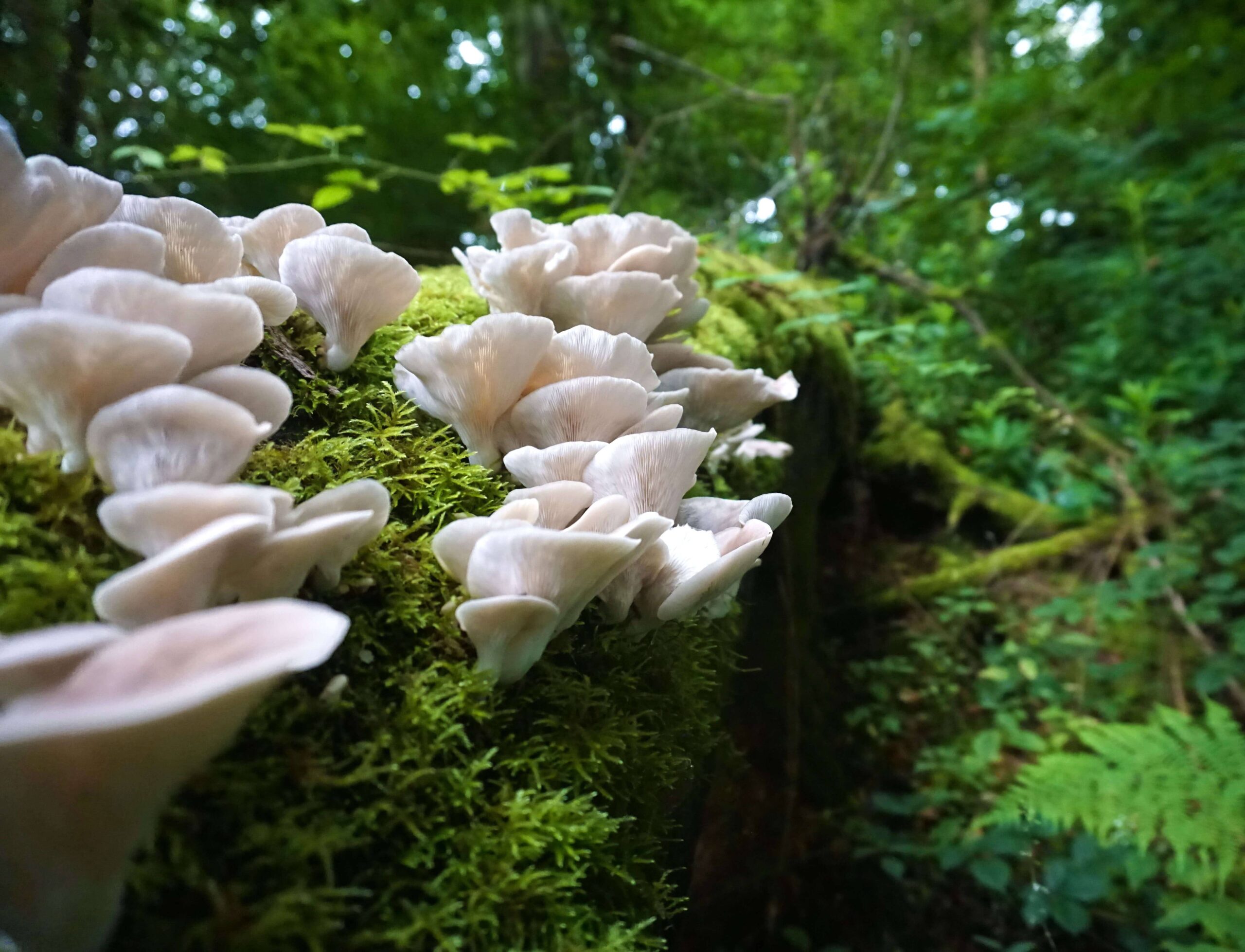
Final Thoughts
Embracing oyster mushrooms can ramp up your culinary adventures. Their unique flavor and texture offer a delightful complexity to both meat-based and vegetarian dishes. So, don’t hesitate; to add this versatile fungal powerhouse to your next shopping list.
Discover the unbeatable experience of cooking with oyster mushrooms today!
FAQs
1. What does an oyster mushroom taste like?
The flavor profile of oyster mushrooms tends to have a mild and subtle taste, somewhat like button mushrooms, but with a unique umami flavor that many liken to meat.
2. Do different color oyster mushrooms taste different?
Different colors of oyster mushrooms have different tastes. For example, white-capped varieties tend to be milder tasting than yellow-capped ones. The white-capped varieties tend to be milder tasting than the yellow-capped ones.
Oyster mushrooms are rich in proteolytic enzymes and have a high amount of potassium, which makes them fruit slightly more often than others.
Their flavor also tends to vary according to the type of forest they grow in and what other plants are present at the same time. Not all oyster mushrooms taste like oysters!
There are more known types of oysters, so let’s see the difference between them when it comes to taste:
What do pink oyster mushrooms taste like:
These have a milder taste than white oyster mushrooms.
what do yellow oyster mushrooms taste like:
These golden oyster mushrooms taste like nuts, have a more robust flavor, and are less common than the other types.
What do King oyster mushrooms taste like (AKA king trumpet mushrooms):
These have a stronger flavor and are the largest variety of oyster mushrooms. The whole growth process of the king oyster mushroom is different than other oyster mushrooms.
What do pearl oyster mushrooms taste like:
These have a subtle flavor and are the smallest variety of oyster mushrooms.
What do Blue oyster mushrooms taste like:
These have a fruity taste and are the most colorful of all oyster mushrooms.
Yes, there are several types of oyster mushrooms such as pearl oysters, king trumpet mushrooms, Phoenix oysters, or “sideways” tree ones – all have slightly varying flavors.
3. Can we eat any type of the available Oyster Mushrooms raw or should we always cook them?
While you can technically eat cultivated oyster mushrooms raw, cooking brings out their depth in flavor leading to delicious mushroom dishes.
4. How vital is cleaning for using Oyster Mushrooms? Do I need to clean the entire Mushroom before use?
When cooking with quick-fried or browned Oyster Mushrooms you must clean them first; removing dirt particles from larger clusters helps retain texture in your dish.

